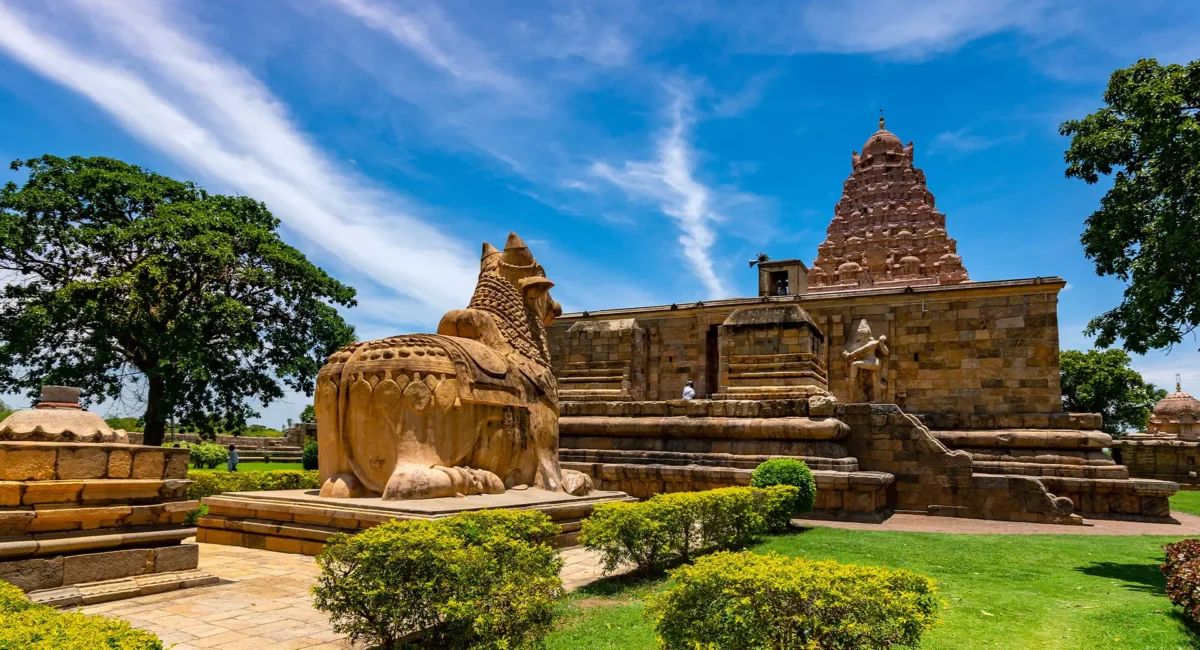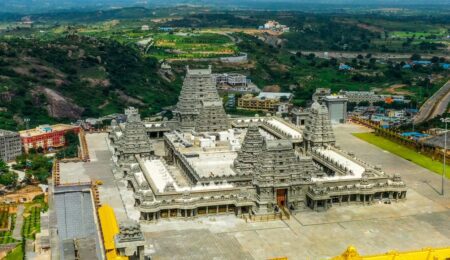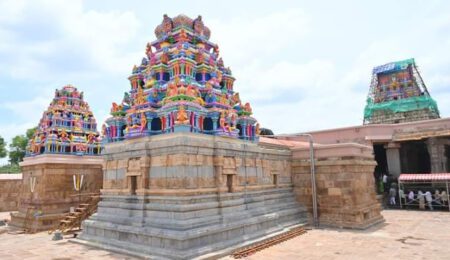Temple of Gangaikonda Cholapuram: A Complete Travel & History Guide
Introduction: The Timeless Grandeur of the Temple of Gangaikonda Cholapuram
Nestled in the historic heart of Tamil Nadu, the Temple of Gangaikonda Cholapuram is one of the greatest architectural marvels of South India. Built in the 11th century by the mighty Chola emperor Rajendra Chola I, this temple stands as a symbol of his victorious campaign to the Ganges and his legacy as one of the greatest rulers in Indian history. Recognized as part of the UNESCO World Heritage Site – The Great Living Chola Temples, this temple is not just a place of worship but also a treasure trove of history, art, and cultural splendor.
From its towering vimana (temple tower) to its intricate sculptures and inscriptions, every inch of this monument narrates tales of the Chola dynasty’s architectural brilliance and spiritual devotion. For travelers, historians, and culture enthusiasts, the Temple of Gangaikonda Cholapuram is a journey through time, offering both divine tranquility and a glimpse into the golden era of Tamil civilization.
Historical Background: The Chola Dynasty’s Legacy
The Temple of Gangaikonda Cholapuram was constructed in 1025 CE under the reign of Rajendra Chola I, the illustrious son of the legendary Raja Raja Chola I, who built the famous Brihadisvara Temple in Thanjavur. After a victorious expedition to the Ganges river in North India, Rajendra Chola brought back the sacred waters of the Ganga and established his new capital, Gangaikonda Cholapuram, meaning “The town of the Chola who conquered the Ganges.”
This city became the Chola empire’s political and cultural capital for over 250 years, surpassing even Thanjavur in significance during its peak. The temple was dedicated to Lord Shiva and was designed as a royal temple, symbolizing the king’s devotion and his empire’s prosperity.
Notable historical highlights include:
- The temple served as a center for both worship and royal ceremonies.
- It housed inscriptions detailing the Chola empire’s administrative, cultural, and economic achievements.
- Despite centuries of invasions and neglect, the temple has retained its grandeur and historical importance.
Architectural Highlights: A Masterpiece of Dravidian Art
The Temple of Gangaikonda Cholapuram is a masterpiece of Dravidian architecture, similar in design to the Brihadisvara Temple of Thanjavur but with its own unique refinements.
Vimana (Temple Tower)
- The vimana rises to about 55 meters, slightly shorter than Thanjavur’s temple, but more graceful and curvilinear.
- It showcases a harmonious blend of grandeur and elegance, making it distinct in Chola temple architecture.
Sculptures & Carvings
- The temple walls are adorned with intricate bas-reliefs and sculptures depicting Hindu deities, mythological tales, celestial beings, and royal processions.
- Notable depictions include Ardhanarishvara (half Shiva, half Parvati), Nataraja (cosmic dancer), and various forms of Lord Shiva.
Temple Layout
- The temple follows the classic axial and symmetrical layout of Chola temples.
- It comprises a massive Nandi Mandapa, a grand gateway, a sanctum (garbhagriha), and spacious courtyards.
Materials & Craftsmanship
- Constructed primarily with granite, the temple has withstood centuries of weather and time.
- The precision in stone carving and architectural planning reflects the Cholas’ engineering excellence.
Cultural & Religious Importance
As a living temple, Gangaikonda Cholapuram continues to be a place of worship and spiritual significance. It is dedicated to Lord Shiva, who is worshipped here as Gangaikondacholisvarar.
Festivals & Rituals
- Maha Shivaratri: The grandest festival, attracting thousands of devotees.
- Navaratri & Pradosham: Celebrated with special rituals and cultural performances.
- Daily poojas and abhishekams are conducted as per traditional Saivaite customs.
Spiritual Significance
- The temple is believed to radiate the blessings of Lord Shiva and the sacred waters of the Ganga brought by Rajendra Chola.
- Pilgrims visit seeking prosperity, spiritual growth, and historical connection.
Travel Guide: Visiting the Temple of Gangaikonda Cholapuram
Best Time to Visit
- October to March: Pleasant weather, ideal for exploring the temple and nearby attractions.
- Avoid peak summer (April–June) due to high temperatures.
Temple Timings & Entry
- Opening hours: 6:00 AM – 12:00 PM & 4:00 PM – 8:00 PM
- Entry Fee: Free (Nominal charges for guided tours may apply)
Photography Tips
- Early mornings and evenings provide the best lighting for photography.
- Tripods are usually not allowed inside the main sanctum.
- Focus on the intricate carvings, Nandi statue, and temple tower for stunning shots.
How to Reach Gangaikonda Cholapuram
By Air
- Nearest Airport: Tiruchirappalli International Airport (~125 km)
- Chennai International Airport (~250 km) for international travelers
By Rail
- Nearest major railway stations: Kumbakonam (35 km) and Thanjavur (70 km)
- Regular trains connect these towns with Chennai, Tiruchirappalli, and Madurai.
By Road
- Well-connected via Tamil Nadu State Highways.
- From Chennai (250 km) – 5.5 hrs by car
- From Thanjavur (70 km) – 1.5 hrs by car
- From Kumbakonam (35 km) – 45 minutes by car
- Regular buses and taxis available.
Nearby Attractions
Visiting the Temple of Gangaikonda Cholapuram opens the door to exploring other Chola and heritage marvels nearby:
- Brihadisvara Temple, Thanjavur – Another UNESCO World Heritage Chola temple.
- Airavatesvara Temple, Darasuram – Famous for its exquisite stone carvings.
- Swamimalai Murugan Temple – One of the six abodes of Lord Murugan.
- Kumbakonam Town – Known for its temples, brassware, and coffee.
- Thiruvaiyaru – Renowned for Saint Tyagaraja’s music festival.
Visitor Tips
- Dress Code: Traditional attire recommended; avoid shorts and sleeveless tops.
- Local Food: Try Tamil Nadu’s authentic vegetarian meals, filter coffee, and temple prasadam.
- Accommodation: Options available in Kumbakonam, Thanjavur, and Chidambaram. Budget hotels, heritage stays, and mid-range lodges cater to travelers.
- Guided Tours: Hiring a local guide enhances the historical and architectural understanding of the temple.
Preservation & UNESCO Recognition
The Temple of Gangaikonda Cholapuram, along with the Brihadisvara and Airavatesvara temples, was inscribed as a UNESCO World Heritage Site in 1987 under the group “Great Living Chola Temples.”
Preservation Efforts
- Managed by the Archaeological Survey of India (ASI) for conservation and restoration.
- Regular cleaning, structural maintenance, and cultural programs help preserve its legacy.
- Awareness initiatives are ongoing to promote heritage tourism responsibly.
Conclusion: Why Visit the Temple of Gangaikonda Cholapuram?
The Temple of Gangaikonda Cholapuram is more than just a monument – it is a living legacy of Tamil Nadu’s golden age, an architectural marvel that narrates the story of a powerful dynasty, and a spiritual center that continues to inspire devotion and admiration. Whether you are a history lover tracing the footprints of the Chola empire, a photographer captivated by ancient architecture, or a traveler seeking heritage and culture, this temple promises a journey unlike any other.
Plan your visit today, and step into a chapter of India’s glorious past that still stands proud under the Tamil sun.




Leave a Comment